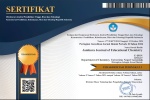Identifikasi Pemahaman Konsep Siswa pada Materi Termokimia Menggunakan Tes Diagnostik Three-Tier Multiple Choice
Abstract
Keywords
Full Text:
PDFReferences
Abdullah, V. R. (2012). Pengertian Penelitian Deskriptif. Medan: Sofmedia.
Astari, I. A. S., Suarni, N. Kt., & Margunayasa, I. G. (2013). Pengaruh Model SDL Terhadap Pemahaman Konsep IPA Kelas IV SDN di Kelurahan Kaliuntu Singaraja 1. Mimbar PGSD Undiksha, 1(1). https://doi.org/https://doi.org/10.23887/jjpgsd.v1i1.697
Bala, R. (2013). Measurement of Errors and Misconceptions: Interviews and Open-ended Tests, Multiple-Choice Tests, Two-tier Tests and Three-Tier Test. Education India Journal, 2(3), 44-60.
Biya, S. A., Isa, I., & Laliyo, L. A. R. (2023). Pengaruh Model Pembelajaran Discovery Learning Terhadap Pemahaman Konsep Pada Materi Termokimia di SMA Negeri 1 Mananggu. Jurnal Pendidikan Kimia Undiksha, 1(1), 23-28. https://doi.org/https://doi.org/10.23887/jjpk.v7i1.59726
Budiman, D. M. (2016). Penerapan Pendidikan Teknologi Dasar pada Pembelajaran Fisika dalam Meningkatkan Pemahaman Konsep Siswa. Gravity: Jurnal Ilmiah Penelitian Dan Pembelajaran Fisika GRAVITY, 2(2), 156-165. https://doi.org/http://dx.doi.org/10.30870/gravity.v2i2.1130
Camelia, P. (2022). Analisis Faktor-Faktor Penyebab Kesulitan Belajar Siswa pada Materi Kelarutan dan Hasil Kali Kelarutan. Blended Learning, 1(1), 23-26. https://doi.org/https://doi.org/10.23887/jpk.v3i1.20944
Cetin-Dindar, A., & Geban, O. (2011). Development of a three-tier test to assess high school students' understanding of acids and bases. Procedia-Social and Behavioral Sciences, 15, 600-604.
Efendi, P. M., Tatang Muhtar, & Yusuf Tri Herlambang. (2023). Relevansi Kurikulum Merdeka Dengan Konsepsi Ki Hadjar Dewantara: Studi Kritis Dalam Perspektif Filosofis-Pedagogis. Jurnal Elementaria Edukasia, 6(2), 548-561. https://doi.org/10.31949/jee.v6i2.5487
Eryilmaz, A. (2010). Development and application of three-tier heat and temperature test: Sample of bachelor and graduate students. Eurasian Journal of Educational Research, 40(1), 53-76.
Hani'ah, Widodo, S. T., Suwandi, S., & Saddhono, K. (2017). Membangun Moralitas Generasi Muda dengan Pendidikan Kearifan Budaya Madura dalam Parebasan. The 1st Education and Language International Conference Proceedings Center for International Language Development of Unissula, 338-348.
Kamra, Y. (2019). Pelaksanaan Kegiatan Ekstrakurikuler dalam Upaya Mengembangkan Lingkungan Pendidikan yang Religius Di SMP N 13 Kota Bengkulu. Al-Bahtsu, 4(2), 158-165. https://doi.org/http://dx.doi.org/10.29300/btu.v4i2.2675
Lestari, M. D., Ma'ruf, Z., & Fakhruddin, F. (2021). Pengembangan Instrumen Tes Diagnostik Two-Tier untuk Mengidentifikasi Miskonsepsi pada Materi Pokok Cahaya Siswa SMP. Jurnal Online Mahasiswa (JOM) Bidang Keguruan Dan Ilmu Pendidikan, 8(1).
Mubarak, S., Susilaningsih, E., & Cahyono, E. (2016). Pengembangan Tes Diagnostik Three Tier Multiple Choice Untuk Mengidentifikasi Miskonsepsi Peserta Didik Kelas XI. Journal of Innovative Science Education, 5(2).
Muderawan, I. W., Wiratma, I. G. L., & Nabila, M. Z. (2019). Analisis Faktor-Faktor Penyebab Kesulitan Belajar Siswa pada Materi Kelarutan dan Hasil Kali Kelarutan. Jurnal Pendidikan Kimia Indonesia, 3(1), 17. https://doi.org/10.23887/jpk.v3i1.20944
Pristiwanti, D., Badariah, B., Hidayat, S., & Dewi, R. S. (2022). Pengertian Pendidikan. Jurnal Pendidikan Dan Konseling, 4(6), 7911-7915. http://repo.iain-
Sanjiwani, N. L. I., Muderawan, I. W., & Sudiana, I. K. (2018). Analisis Kesulitan Belajar Kimia pada Materi Larutan Penyangga di SMA Negeri 2 Banjar. Jurnal Pendidikan Kimia Undiksha, 2(2), 75. https://doi.org/10.23887/jjpk.v2i2.21170
Simatupang, A. (2021). Hubungan Motivasi Belajar dengan Hasil Belajar Siswa pada Mata Pelajaran Kimia di SMA Negeri 2 Kota Jambi. Secondary: Jurnal Inovasi Pendidikan Menengah, 1(3), 199-205. https://doi.org/10.51878/secondary.v1i3.346
Sugiyono. (2018). Metode Penelitian Kuantitatif, Kualitatif dan R&D. Alfabeta.
Uge, A., Lukum, A., & Rumape, O. (2021). Pengaruh Model Pembelajaran Discovery Learning dengan Metode Demonstrasi "ŽTerhadap Pemahaman Konsep Reduksi Oksidasi pada Siswa Kelas X SMA Negeri "Ž"Ž1 Suwawa. Jambura Journal of Educational Chemistry, 2(2), 74-78. https://doi.org/10.34312/jjec.v2i2.7181
Umasugi, H., Tinggi, S., Islam, A., Sula, B., & Utara, M. (2020). Guru Sebagai Motivator. Juanga: Jurnal Agama Dan Ilmu Pengetahuan, 06(2). https://doi.org/https://doi.org/10.59115/juanga.v6i02.7
DOI: https://doi.org/10.34312/jjec.v5i2.13255
Refbacks
- There are currently no refbacks.
Editorial Office

|
Department of Chemistry, Universitas Negeri Gorontalo |

|
E-mail: jjec@ung.ac.id |

|
|

|
Jambura Journal of Educational Chemistry (p-ISSN: 2655-7606 | e-ISSN: 2656-6427) by Department of Chemistry Universitas Negeri Gorontalo. This work is licensed under a Creative Commons Attribution 4.0 International License. Powered by Public Knowledge Project OJS |










